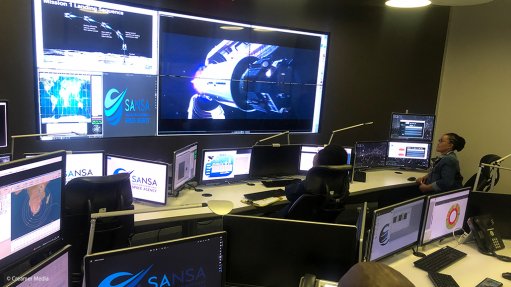
Sansa's mission control
Photo by: Creamer Media's Darren Parker
The South African National Space Agency (Sansa) will be providing mission critical communication support to the United Arab Emirates’ Mohammed bin Rashid Space Centre (MBRSC), which is aiming to land the first Emirati lunar rover Rashid on the moon between 16:40 and 18:15 this evening as part of its Emirates Lunar Mission.
Sansa will play a key role throughout the rover’s four-week mission by providing the means for communicating with and controlling the rover from Earth.
Sansa will transmit commands from its 12 m S-band dish and will receive telemetry and data through the South African Radio Astronomy Observatory’s (SARAO’s) 26 m dish. Prior to the landing on April 25, Sansa chief engineer Eugene Avenant explained that the large SARAO dish was needed to detect the extremely faint signals coming from the rover on the moon’s surface.
The Emirates Lunar Mission is part of a new 2021 to 2031 strategy launched by the MBRSC, which included the development and launch of Rashid, which was named after the late Sheikh Rashid bin Saeed Al Maktoum, the builder of modern Dubai.
Rashid is one of the most compact lunar rovers ever made, designed and manufactured by MBRSC, measuring about 500 mm x 500 mm and weighing only about 10 kg.
The Emirates Lunar Mission will also be the first mission to the lunar surface by an Arab country.
It will study various aspects of the moon such as the thermal properties of the lunar surface and the formation and components of lunar dust. On addition, the Rashid rover will capture photographs and collect information and data from the Atlas crater in the Mare Frigoris region of the lunar landscape, which will be explored for the first time.
This research is designed to help pave the way for human exploration beyond the moon.
The Emirates Lunar Mission is a pivotal step towards the MBRSC’s Mars 2117 programme, which aims to build a human settlement on Mars by 2117.
The Emirates Lunar Mission spacecraft – the iSpace Hakuto-R M1 – carrying the Rashid rover, was successfully launched from Cape Canaveral in Florida on December 11 and has been en route to the moon for the past 135 days.
The intense entry, descent and landing (EDL) phase, which will take place this evening, is the most difficult part of the journey, as the iSpace Hakuto-R M1 will have to land on the lunar surface without a human being on board to navigate.
This will mean relying on the lunar lander's computers to calculate how the spacecraft should fire thrusters to stay on course for the specific landing spot on the moon, where it will hopefully not encounter unexpected craters or boulders which could unbalance the craft.
According to Sansa navigation technician Farhad Hassim, as many as one out of every three attempted remote lunar landings fail at the EDL stage, which makes the landing a tense moment.
“As much as we hope it's successful, there is a possibility of failure. We've seen in the last year or two, a number of unsuccessful missions to the moon,” Avenant said.
Hassim explained to Engineering News that the reason that lunar landings were so challenging was because of the lack of any atmosphere and very low gravity, which negates the possibility of using parachutes and results in a much more complex descent that relies entirely on thrusters and sensors.
Once the ship has landed on the lunar surface, a four-hour-long deployment and commissioning phase will begin. Following the completion of the post-landing checkout, instrument commissioning and initial data collection will then begin, with communication checks being part of the instrument commissioning.